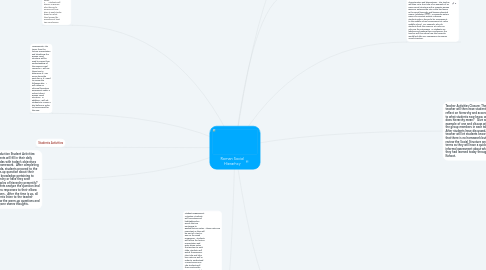Roman Social Hierarhcy
von Guadalupe Diaz De Leon

1. Assessments: The terms from the lecture presentation and classifying the Roman social structure will be used to assess their understanding of the Roman Social Hierarchy. I will use these two to determine if I can move along the next day or if I need to review the following day. I will utilize an informal formative assessment under a Kahoot about Roman Social Structure. In addition, I will ask students to review a day before in order to be prepared for the quiz.
2. Students Activities
3. Instructional Objectives • Students will define a hierarchy as they will analyze the Roman social hierarchy (Emperor, Patricians, Plebians, Slaves) and later compare it to their school setting by constructing their own social pyramid. • Students will classify the different social classes in Rome by depicting their own interpretations of each of the four social classes in the guided/lecture notes. • Students will discuss in groups what hierarchy means and how does it apply today based on what they learned by providing at least two conclusions.
4. Introduction Student Activities: Students will fill in their daily agendas with today’s objectives and homework. After completing agenda, students proceed to the Warm-up question about their prior knowledge pertaining to hierarchy or have they seen examples of hierarchy presently? Students analyze the question and discuss responses to their elbow partners. After the time is up, all students listen to the teacher review the warm-up questions and everyone shares thoughts.
5. Student Engagement Activities: Students will be writing and highlighting key words that are pertaining to guided/lecture notes. These notes are important as they will be part of a test or quiz as the week progresses. Students will follow the lecture presentation and write down notes that pertain to each slide. Students will watch the Emperor short clip and take key notes as well in order to understand Ancient Rome B.C. The students will then practice the comparison model with Yorba middle school and making their hierarchy pertaining to the school environment. The students listen to the teacher’s instructions pertaining to tomorrow’s groups presentations on assigned social strata. Students will also take notes on assessment expectations on content and presentation.
6. Teacher Activites
7. Intro Teacher Activities: As students arrive to the classroom, the teacher will have students fill in agenda, regarding today’s objectives and homework. The students will then switch over to the Warm-Up question asking students if they know what hierarchy means or have students seen any examples of hierarchy in their present lives? The teacher will give students four to five minutes to discuss with their elbow partners their responses. The teacher will keep track of time by having a timer set on the Smart Board and letting all students to keep track of time. After the time is up, the teacher will develop a quick class discussion about their thoughts about the Warm-up question.
8. Student Engagement Teacher Activities:The lectures presentation will begin by reviewing content specific vocabulary such as Plebians, Patricians, Hierarchy, Social structure, slaves and letting students know that these are key words that should be highlighted for them to know. The teacher will instruct students to follow the guided notes and the powerpoint presentation as they will go hand in hand in the procession. I will then begin defining what a hierarchy is along with visual representations of them. The students will then analyze Rome’s Social Structure to identify each groups characteristics and descriptions. The teacher will then set a short clip of an example of an Rome social structure with a majestic Roman Emperor entering the city as the key figure in the social hierarchy and having unlimited power (Gladiator (2000) - Commodus enters Rome The practice activity is having students make a hierarchy by comparing it to the Middle School environment at Yorba Middle School. For example, who do students think the emperor at Yorba is? Who are the Patricians? As students are labeling and making their conclusions, the teacher will then show how the hierarchy would look like as a comparison to Rome’s Social Structure.
9. Teacher Activities Closure: The teacher will then have students reflect on hierarchy and according to what students now know, what does hierarchy mean? Give an example of one and discuss with the group members in each table. After students have discussed, the teacher will let students know that there is no homework but to review the Social Structure and terms as they will have a quick informal assessment about what they had learned today through Kahoot.
10. Student Closure: Students reflect on hierarchy according to what they learned from the lecture/guided notes. Students will then discuss with group members about what they have learned from the lecture. Listens to teacher’s instructions and writes down in agenda to review guided notes on Roman social structure and hierarchy.


